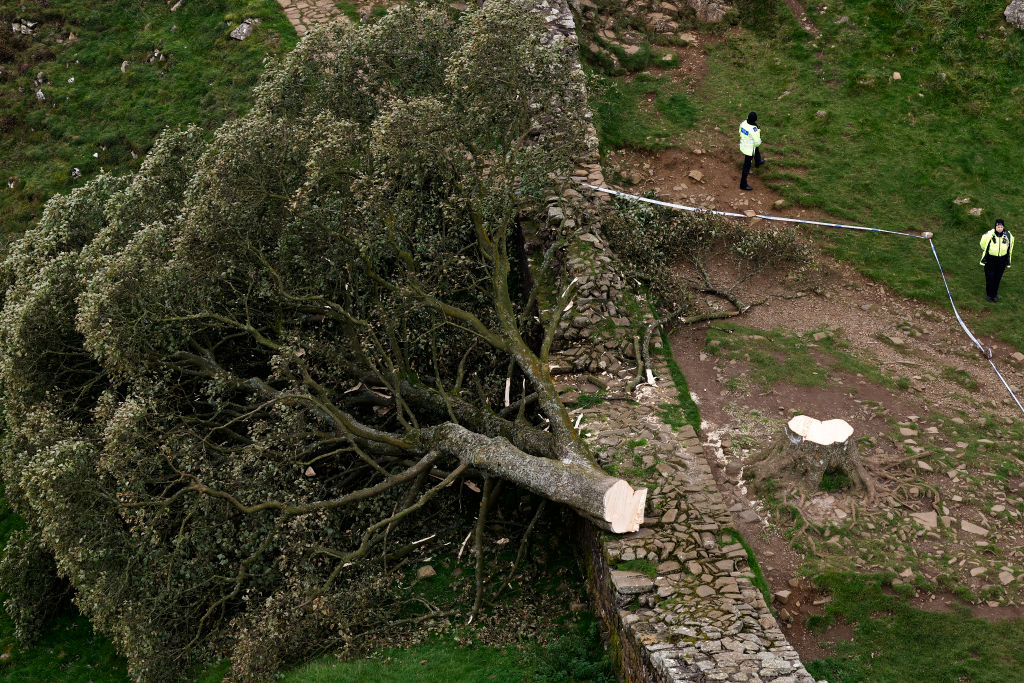My ancestors presumably had something to do with trees — and true to my heritage, I enjoy some amateur forestry on my land in Vermont. The crack, the whoosh and the thunder of a tree coming down exactly where you aimed it thrills the Upper West Side me, chainsaw in hand.
But it grieves me when a good tree is blown down or uprooted. I cut only those that have to be removed because they are dying or might crush house or head if not tended to.
The Spectator reports on the murder of the Sycamore Gap, a 300-year-old tree along Hadrian’s Wall, chainsawed by a vandal when no one was looking. The culprit apparently is a sixteen year-old boy. It was an act of gratuitous violence. But not a singular act.
Around the world, iconic trees are subject to such attacks. In 2020, someone cut off the lower limb of New Zealand’s most famous tree, the Wanaka, a willow that stood partially submerged off the shore of Lake Wanaka on South Island.
It wasn’t the first attempt in New Zealand at arboricide. Back in 1994 a Maori activist, Mike Smith, took a chainsaw to the solitary pine atop Auckland’s “One Tree Hill.” The tree survived for five years until some other activists finished the act. Smith was proud of his work and you can see him in a video boasting of his success in igniting Maori protest by killing the tree.
One Tree Hill gained additional fame when the rock group U2 used it as the title of a song in 1987. The song appeared on their album The Joshua Tree, which featured an image of the Mohave Desert that included a silhouetted Joshua tree in the background. Naturally, someone came along and hacked off one of its limbs. It died in 2000.
In 2010, vandals hacked apart “the Holy Thorn Tree of Glastonbury.” It was only fifty years old, but was planted where an older tree had stood and was the site of a Christian pilgrimage. Cromwell’s troopers had cut down the tree in the 1640s because it was associated with Catholic rites, but locals preserved the roots and replanted it. So the tree has been through several incarnations and deaths.
In 2000, vandals wounded “Luna,” a thousand year-old redwood in California that came to fame when an environmental protester, Julia Butterfly Hill, staged a two-year protest by sitting in its canopy. From December 1997 to December 1999, she hung out in the canopy to prevent the Pacific Lumber Company, which owned it, from cutting it down. The company agreed, but apparently someone else didn’t.
In 2017, someone cut deeply into the trunks of the “Broccoli Tree,” a crack willow that had become the most famous tree in Sweden, thanks to the photographs of Patrik Svedberg. No one knows who did it or why. Willows, being stubborn, refused to give up. The Broccoli Tree no longer looks like broccoli, but perhaps a bit like frisée, but at least it lives.
In 1989, a man poisoned the Treaty Oak in Austin, a 600-year-old tree which was the last remaining of fourteen known to Native Americans as the Council Oaks. The tree survived barely, and the culprit was sent to prison for nine years. His motive was unrequited love for his counselor at his methadone clinic. The herbicide he poured around the tree was supposed to be a magic spell of some sort.
But the man who poisoned the Toomer’s Corner Twin Oaks in Auburn, Alabama, in 2010, was out for revenge because Auburn University had beat his favored team, the University of Alabama, in the Iron Bowl. The trees died. The killer, a retired state trooper, got seventy days in jail.
Those are all examples of willful tree killing out of spite. Then there are those instances of stupidity and folly: the female meth addict who in 2012 crawled into a hollow of the Senator, a 3,500-year-old cypress in Florida and set it on fire. Goodbye world’s fifth oldest tree. Then there was graduate student who wanted to count the tree rings of the world’s oldest tree, a bristlecone pine called Prometheus. So naturally he cut it down. That was in 1964 — and it turned out that Prometheus was 5,000 years old. It would be 5,059 if Donald Curry had been in less of a hurry.
But meth and scientific arrogance are just facts of life. What do we make of the seemingly widespread urge to destroy trees because they are beautiful, well-loved or cherished by others? The culprits never seem possessed by tree-hatred, if there is such a thing. Rather, they seem to act on misanthropy. They seeks to destroy what others love simply because other love it. They enjoy the sense of power that comes with attacking something that cannot fight back but that is incontestably more powerful in a dimension they can never match. Anger is the motive at the simplest level — anger against the colonists who displace the Maori, against the rival football team, the drug counselor, the environmental activist or the tourists.
I don’t know that killing iconic trees is a necessarily a modern pathology, but it does seem to have a touch of that contemporary unfocused rage: “If I can’t love it, at least I can destroy it. And when I do I will make others suffer some of the rage and grief that consume my own soul.”
And what is to be done about this brokenness? We plainly cannot post an armed guard around every famous tree. And it would be very hard to hide such trees. They make themselves known, even without the help of Swedish photographers. We are faced with a particularly stark example of cultural disintegration. We are all hostage to every bitter person with a chainsaw or an ax and a license to pursue his twisted vendetta against nature and civilization.

























